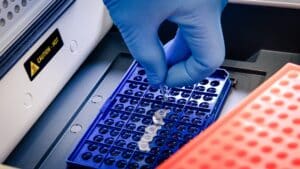Rethinking Particle Analysis: How Automated Particle Imaging Accelerates Biologics Development
May 8, 2025
In biopharmaceutical development, precise particle characterization isn't just important - it's paramount. Ensuring the stability of biologic formulations and guaranteeing patient safety hinges on a deep understanding of particle size, distribution, and identity.
Traditional methods often fall short, creating bottlenecks and risks. This is where automated particle imaging emerges as a transformative technology.
By integrating advanced microscopy with powerful artificial intelligence, it revolutionizes how scientists analyze biologics, providing unprecedented, decision-driving data faster and more reliably than ever before [1][2]. Rethinking particle analysis with these innovative tools is key to accelerating development timelines and bringing safer, more effective therapies to market.

Overcoming the Hurdles of Traditional Biologics Analysis
Biologics, complex molecules derived from living organisms, present unique analytical challenges, partly due to their large size, which makes them inherently difficult to characterize thoroughly using traditional imaging and analysis techniques. Established methods like light obscuration and manual microscopy often lack the required sensitivity and precision. These conventional approaches are frequently hampered by large sample volume requirements and an inability to accurately characterize critical subvisible particles, underscoring the need for innovative solutions that deliver superior accuracy and efficiency [1][2].
Historically, the biopharmaceutical industry relied heavily on manual techniques for particle analysis. While foundational, these methods proved labor-intensive and susceptible to human error and variability [2]. Manual microscopy, for example, demands highly skilled operators for particle identification and classification, leading to inconsistent results. Furthermore, traditional methods often fail to reliably detect and characterize particles smaller than 10µm, a critical size range for assessing the safety and efficacy of biologics.
The Limitations Holding Back Conventional Methods
Conventional particle analysis methods face significant hurdles that impede efficient biopharmaceutical development. Beyond the high sample volumes often required, which delay analysis [1], these traditional techniques suffer from several critical shortcomings.
They often exhibit limited resolution and sensitivity, making it difficult to detect smaller, yet potentially critical, subvisible particles. Furthermore, they typically provide inadequate structural characterization and offer limited functional insight into the particles observed. There are also physics-related constraints with older methods, which rely on liquid-based samples. Measurements made on liquid samples often miss particles with the same refractive index as the medium in which it is, leading to undercounting and misinformed particle analysis. For example, glass and proteins have nearly the same refractive index as water, which would make it very difficult to characterize them in conventional particle analysis methods.
The processes themselves are frequently time-consuming and labor-intensive, prone to human error and variability. Many conventional methods struggle with incompatibility with new therapeutic modalities and lack capabilities for real-time or in-process monitoring, hindering process analytical technology (PAT) initiatives.
Finally, scalability issues can make these methods impractical for high-throughput screening or large-scale manufacturing needs. These combined limitations underscore the urgent need for a paradigm shift towards more advanced, automated particle analysis solutions.
The Power of Automated Particle Imaging Technologies
Automated particle imaging technology, exemplified by innovative systems like Halo Labs' Aura® PTx, directly addresses the limitations of conventional methods. It offers a suite of advanced features designed to simplify workflows and significantly enhance the accuracy and depth of particle analysis [1][2]. This technology empowers researchers by:
- Enhancing resolution and specificity for more precise particle detection and visualization.
- Characterizing particles comprehensively, going beyond simple size and concentration to provide richer morphological data.
- Enabling functional or identity tagging (e.g., via fluorescence or other microscopy approaches) to definitively differentiate particle types and contaminants.
- Offering higher throughput and automation, dramatically accelerating analysis timelines and freeing up valuable researcher time.
- Performing non-destructive and rapid analysis using minimal sample volumes, conserving precious material.
- Demonstrating applicability to emerging therapeutic modalities where traditional methods may falter.
- Supporting robust regulatory compliance and risk mitigation through consistent, reliable data generation.
Unlike traditional methods, automated particle imaging leverages sophisticated optics and intelligent machine learning algorithms to deliver a comprehensive analysis of particle size, shape, identity, and composition.
This technology excels at identifying and characterizing subvisible particles, often missed by conventional techniques. By integrating high-resolution imaging with AI-driven analytics, automated systems like the Aura family provide unparalleled precision and reliability, turning particle data into actionable insights.
Technological Foundations: Seeing More with Less
- Low Sample Volume Requirements:
A key advantage is the ability to work with microliter volumes. Automated systems enable crucial analysis much earlier in the development process, conserving precious samples and allowing for more frequent testing [1][2]. - High Contrast Imaging:
Innovative techniques like Backgrounded Membrane Imaging (BMI) eliminate the need for liquid phase detection, delivering exceptionally clear images even when particles have refractive indices similar to the surrounding solution [1]. - Advanced Detection and Identification:
Capable of analyzing a broad spectrum of visible and subvisible particles (typically ranging from <1µm to >5mm), these technologies provide precise morphological classification. The integration of Fluorescence Membrane Microscopy (FMM) allows for specific identification through fluorescent labeling, differentiating protein aggregates from contaminants like silicone oil droplets or process impurities [5][7].
The integration of fluorescent labeling is a true game-changer. This capability allows researchers to definitively identify particles, providing a detailed compositional breakdown of the sample. Such granular insights are invaluable for optimizing biologic formulations, troubleshooting issues, and ensuring final product quality and safety.
High-Throughput Capabilities: Accelerating Discovery and Development
Modern automated particle imaging systems are designed for high-throughput workflows, enabling the rapid analysis of large sample batches, often in standard well-plate formats. This efficiency significantly accelerates development timelines and minimizes the potential for errors associated with manual handling and data transfer [1].
High-throughput capabilities are particularly impactful in process development and quality control environments. By analyzing numerous samples or conditions concurrently, automated systems drastically reduce the time and resources needed for comprehensive particle characterization. This speed is especially critical in large-scale manufacturing, where timely, accurate analysis directly influences production outcomes and batch release decisions.
AI-Enhanced Analytics: Turning Data into Decisions
Incorporating sophisticated machine learning algorithms, these systems elevate data analysis by accurately segmenting, classifying, and quantifying particles based on complex morphological and fluorescent parameters. This AI-driven approach significantly boosts the reliability and depth of results, providing researchers and developers with clear, actionable insights [5][7].
The application of AI represents a significant leap forward, with machine learning models that can process vast image datasets in real-time, identifying subtle patterns and correlations that would be impossible for a human operator to detect consistently. This not only enhances the accuracy of particle characterization but also opens doors for predictive analytics, helping researchers anticipate potential formulation or process issues before they escalate.
Key Insights: Strategic Applications Across Biopharmaceutical Development
Automated particle imaging, particularly with versatile systems like the Aura PTx, transcends basic analysis, becoming a strategic development tool. It delivers critical insights that transform various stages of the biopharmaceutical pipeline, from early-stage formulation optimization through to late-stage process analytical technology (PAT) implementation and quality control [2][9].
The adaptability of automated particle imaging makes it an indispensable asset. From pre-clinical research to commercial production, this technology provides the high-quality data needed to drive innovation, ensure product quality, and navigate the complexities of biologic development.
Early-Stage Formulation Optimization
During the crucial pre-clinical phase, automated particle imaging rapidly identifies potential stability issues or incompatibilities between biologic formulations and container materials. By accurately quantifying and identifying particles, even down to the submicron level, this technology helps mitigate contamination risks and ensures the stability and efficacy of the intended product [2][8].
Formulation optimization is inherently complex and iterative. Automated particle imaging streamlines this process by delivering detailed, quantitative data on particle behavior under diverse stress conditions or across different formulation candidates. This enables researchers to screen and select optimal formulations more efficiently, significantly reducing the time and cost associated with early-stage development.
Process Analytical Technology (PAT) Implementation
Automated particle imaging plays a crucial role in modern Process Analytical Technology (PAT) strategies. The integration of inline or at-line particle imaging capabilities facilitates continuous or frequent monitoring of critical quality attributes, such as cell culture viability or aggregation levels during purification.
Real-time or near-real-time analysis during production enables data-driven process optimization, potentially improving harvest times, reducing batch failures, and ensuring greater consistency in yields [4][13]. By providing timely data on particle characteristics, automated imaging supports a more proactive, science-based approach to process control, enhancing both product consistency and regulatory compliance.
Regulatory Compliance and Comparability Assessments
Meeting stringent regulatory expectations is non-negotiable. Automated particle imaging systems generate the detailed particle size distribution curves, morphological data, and compositional breakdowns required by health authorities. Such precise, objective data support compliance with relevant standards, including USP <787> and <1788>, thereby streamlining comparability studies and regulatory submissions [2][9].
Navigating regulatory compliance is a significant undertaking. Automated particle imaging simplifies this by providing robust, reproducible, and traceable data that meet the highest standards of quality and accuracy. This not only facilitates smoother regulatory interactions but also builds confidence in product quality among all stakeholders.
Embrace the Future, Rethink Particle Analysis
As the biopharmaceutical industry pushes the boundaries of innovation, the demand for faster, smarter, and safer particle analysis becomes ever more critical. Automated particle imaging represents a necessary paradigm shift, combining enhanced precision, depth of information, and streamlined high-throughput workflows. Technologies such as the Aura PTx empower drug developers with the clear, decision-driving data needed to make informed choices, ultimately improving patient safety and accelerating the delivery of life-changing therapeutics [1].
The future of biologics analysis lies in leveraging advanced technologies like automated particle imaging. By embracing these innovations, the industry can overcome persistent challenges, unlock new efficiencies, and confidently advance the next generation of biopharmaceuticals.
Transform Your Biologics Analysis with Aura
Ready to revolutionize your particle analysis and accelerate your development pipeline? Discover how Halo Labs' Aura family of instruments can simplify workflows, deliver deeper insights, and enhance accuracy in your particle characterization processes. Contact us today to learn more about how our innovative solutions can empower your team to develop faster, smarter, and safer.
Citations
[1]https://www.nanoscience.com/blogs/automated-sem-the-future-of-particle-analysis/
[3]https://crnova.com/the-dna-of-innovation-the-marriage-of-technology-and-biology/
[4]https://www.baseclick.eu/science/glossar/live-cell-imaging/
[7]https://bioengineer.org/revolutionary-ai-models-set-to-transform-protein-science-and-healthcare/
[8]https://www.leicabiosystems.com/us/news-events/bio-techne-partnership-expansion/
[10]https://www.pnas.org/doi/10.1073/pnas.2315002121
[12]https://spj.science.org/doi/10.34133/bmr.0178
[13]https://pmc.ncbi.nlm.nih.gov/articles/PMC12027720/
[14]https://pubs.acs.org/doi/10.1021/acsphotonics.5c00123
[15]https://pmc.ncbi.nlm.nih.gov/articles/PMC12004724/
DISCOVER THE AURA FAMILY
Read More ON this topic
 Skip to content
Skip to content








